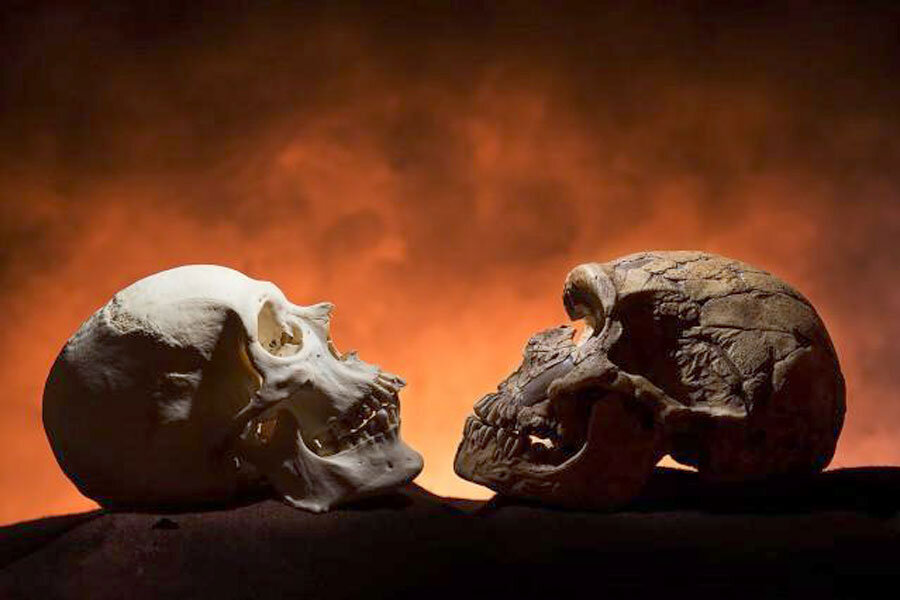Why do humans have chins?
Loading...
This is really a story about humanity's capacity for progress, but we're going to lead with the chin.
Humans are the only animals, aside from elephants for some reason, to sport a bony protrusion at the end of the lower mandible. No other ape – not chimps nor gorillas nor orangutans – has one. Not even the Neanderthal, our nearest evolutionary relative, had a chin.
Why is that? It's a question that has, for more than a century, left anthropologists stroking the very anatomical feature under consideration.
Some scientists have argued that the bony material on the chin grows as one develops into adulthood as a result of mechanical forces, buttressing the back of the jaw to help with chewing. But a new analysis tells a different story.
Led by Nathan Holton, an anthropologist in the Department of Orthodontics at the University of Iowa's College of Dentistry, the research team analyzed data from the Iowa Facial Growth Study, which took periodic craniofacial measurements of male and female subjects ranging from toddlers – who generally don't really have much of a chin to speak of – to twentysomethings, who usually do, even if it seems as though half of them are covered with beards. They found that the mechanical forces generated by chewing are not capable of producing the resistance that would create new bone at the tip of the jaw.
In fact, they found the opposite: those with the greatest mechanical stresses on their jaws had the least prominent chins.
"In short, we do not find any evidence that chins are tied to mechanical function and in some cases we find that chins are worse at resisting mechanical forces as we grow," said Dr. Holton in a UI news release. "Overall, this suggests that chins are unlikely related to the need to dissipate stresses and strains and that other explanations are more likely to be correct."
Instead, the researchers' findings, which are published in the current issue of the Journal of Anatomy, indicate that the chin developed as a result of our faces getting smaller as we evolved from archaic Homo sapiens to modern ones.
Beginning about 80,000 years ago, and accelerating about 20,000 years later following another wave of human migration out of Africa, human faces changed. Our brow ridges became less prominent, and most parts of our faces shrank, except for the chin, which then appeared more prominent.
Okay, but why did our faces shrink in the first place?
In August 2104, University of Iowa anthropologist Robert Franciscus, who is a co-author on this current paper, worked on a study that analyzed changes in human faces from the Middle Pleistocene to recent times, comparing them with the skulls of two populations of foxes in Russia that have been specifically bred for tameness and aggression. The changes, that study's researchers argued, are consistent with changing levels of hormones related to the development and maintenance of masculine characteristics, particularly testosterone.
The hormonal changes were associated with behavioral changes. As population density increased, small bands of hunter-gatherers began to encounter one another more frequently. As the number of interactions with outsiders increased, those who were less aggressive and more empathetic toward unfamiliar people – which tended to be men with relatively lower levels of testosterone – finally began to see success, cooperating to obtain food and sharing techniques to make tools, for instance.
"What we're arguing is that modern humans had an advantage at some point to have a well-connected social network, they can exchange information, and mates, more readily, there's innovation," says Franciscus in the press release, "and for that to happen, males have to tolerate each other."
Over time, these original economic girlie men had more reproductive success than their more hostile and aggressive counterparts. Even greater social tolerance led to greater population density, and eventually more gracile faces came to dominate the gene pool.
And it all happened, the researchers argue, because humans started developing wider social networks. As anthropologist Kim R. Hill and colleagues found in a study published last year even those living in relatively isolated hunter-gatherer societies, such as the Hadza of eastern Africa and the Aché people of Paraguay – have large social networks, with the average male observing more than 300 men making tools over his lifetime. By comparison, male chimpanzees, our closest living relative, interact with only about 20 other male chimps in their lifetime.
This high level of social interaction, Dr. Hill and his colleagues propose, is what allows humans, unlike chimps, to accumulate improvements over time.
That seems to be what happened to our species. First, over six million years or so, we diverged from other primates and evolved into something that looks more or less like a modern human, but with a big face, no chin, and a xenophobic streak.
Then, as we started learning to live with each other, to cooperate and share, we continued to evolve, becoming ever more distinct from our fellow apes. Our tools became more precise. We began trading goods over longer distances. We decorated our bodies. We created art. We began to sing and dance. We buried our dead.
As the New Yorker's Adam Gopnik warned last year, it would be far too simplistic to say that all this is the result of a change in hormones, or vice versa. Behavioral modernity – a term used by anthropologists to mean basically everything that humans have done for the past fifty or sixty millenniums – does not have a single cause. But, if these researchers are correct, the origins of our civilization, and of our ability to improve it over time, are written on your face.








